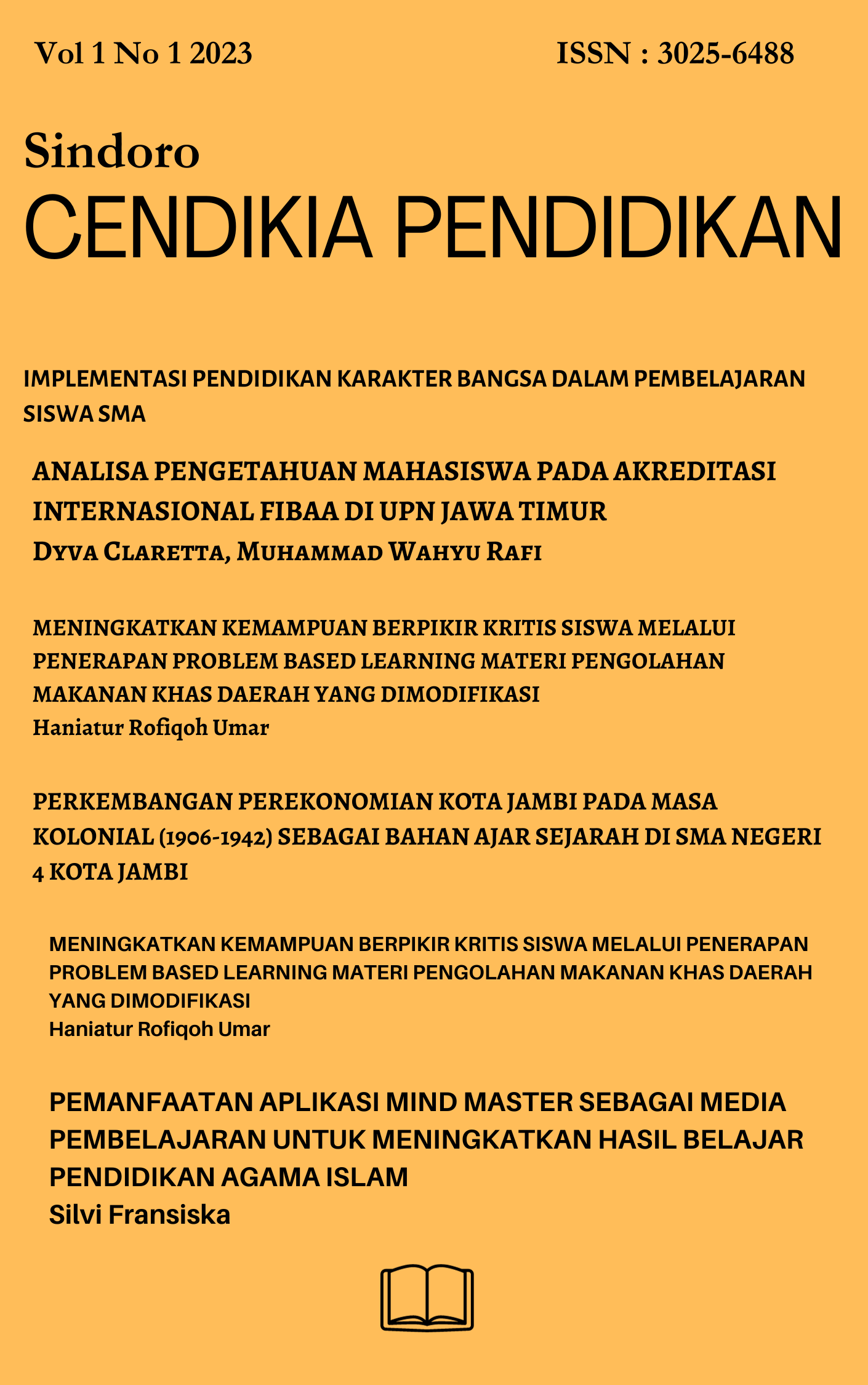APPLICATION OF NAHWU IN ARABIC LANGUAGE LEARNING: A CASE STUDY OF BEGINNER STUDENTS
Main Article Content
Abstract
This research discusses how the science of Nahwu is very important for learning Arabic. The science of Nahwu helps us understand how the meaning and structure of sentences change; this is very important to correctly interpret the meaning of the Arabic text. Learning Arabic includes elements such as vocabulary, grammar, phonology, and cultural context. All of these elements contribute to the ability to communicate well. In addition, this study found problems faced by beginners when learning Arabic. They found that it is essential to create a supportive learning environment. To improve student interaction and understanding, qiyasi and istiqraiyah methods are used in Nahwu learning. Structured memorization, practical exercises, and periodic evaluations are methods to improve student understanding. The results show that students' understanding of Arabic sentence structure can be improved by applying the right approach. This study emphasizes the need for a pen.
Article Details

This work is licensed under a Creative Commons Attribution-NonCommercial 4.0 International License.
This work is licensed under a Creative Commons Attribution-ShareAlike 4.0 International License.
Authors who publish with this journal agree to the following terms:
- Authors retain copyright and grant the journal right of first publication with the work simultaneously licensed under a Creative Commons Attribution License that allows others to share the work with an acknowledgement of the work's authorship and initial publication in this journal.
- Authors are able to enter into separate, additional contractual arrangements for the non-exclusive distribution of the journal's published version of the work (e.g., post it to an institutional repository or publish it in a book), with an acknowledgement of its initial publication in this journal.
- Authors are permitted and encouraged to post their work online (e.g., in institutional repositories or on their website) prior to and during the submission process, as it can lead to productive exchanges, as well as earlier and greater citation of published work
References
Addawami, A. A., Saifullah, I., Nasrullah, Y. M., & Usman, A. T. (2024). PENERAPAN METODE AMTSILATI PADA PEMBELAJARAN NAHWU SHOROF DALAM MENINGKATKAN KETERAMPILAN MEMBACA KITAB KUNING. 4.
Amalia, N. N., Ramadhani, N. H., & Mulyani, R. E. (2025). Optimalisasi Quizalize sebagai Asesmen Formatif dalam Pembelajaran Nahwu Berbasis Community Language Learning. Jurnal Pendidikan Bahasa dan Sastra.
Fauzi, A. R., Enjang, E., & Luthfi, T. (2024). Meningkatkan Pemahaman Kaidah Ilmu Nahwu Melalui Penerapan Rumus Arab Pegon di Majlis Ta’lim Nurul Ilmi Desa Ciracas. Abdimas Galuh, 6(1), 933. https://doi.org/10.25157/ag.v6i1.13790
Fil Amri, F., Gamasari, R., & Amin, I. (2024). Maojok: Akulturasi Ilmu Gramatika Arab di Minangkabau (Studi Kasus Pondok Pesantren Nurul Yaqin, Ringan-Ringan): Urgensi Ilmu Gramatika Arab bagi Pelajar Pesantren di Indonesia. AL MA’ANY, 3(1), 1–10. https://doi.org/10.56874/almaany.v3i1.1863
Ghoffar, A. M., & Muid, F. A. (2024). Strategi Efektif untuk Meningkatkan Pemahaman Nahwu dalam Pembelajaran Bahasa Arab. Journal of Practice Learning and Educational Development, 4(4). https://doi.org/10.58737/jpled.v4i4.313
Hanifansyah, N., & Mahmudah, M. (2023). Strategi Efektif Simplifikasi Nahwu dalam Percakapan Arab pada Kelas Intensif Daurah Ramadhan.
Haq, U. S., & Fitrianto, I. (2023). Implementasi Metode Al-Qiyasiyyah Dan Al-Istiqrariyyah Terhadap Pembelajaran Ilmu Nahwu.
Jailani, M., Wantini, W., Suyadi, S., & Bustam, B. M. R. (2021). Meneguhkan Pendekatan Neurolinguistik dalam Pembelajaran: Studi Kasus pada Pembelajaran Bahasa Arab Madrasah Aliyah. Jurnal Pendidikan Agama Islam Al-Thariqah, 6(1), 151–167. https://doi.org/10.25299/al-thariqah.2021.vol6(1).6115
Khasairi, Moh., Nawawi, M. S., & Irhamni, I. (2019). PENERAPAN LESSON STUDY UNTUK MENINGKATKAN PERFORMANSI MENGAJAR DOSEN DALAM PERKULIAHAN NAHWU DI KELAS. Bahasa dan Seni: Jurnal Bahasa, Sastra, Seni, dan Pengajarannya, 46(2), 167–178. https://doi.org/10.17977/um015v46i22018p167
Rifa’i, M., Hasanah, I., Zubairi, Z., & Sa’ad, M. (2022). Implementasi Contextual Teaching And Learning (CTL) Dalam Meningkatkan Prestasi Belajar Siswa Pada Materi Bahasa Arab: (Studi Kasus di MTs Nurul Jadid Paiton Probolinggo). TARQIYATUNA: Jurnal Pendidikan Agama Islam dan Madrasah Ibtidaiyah, 1(2), 68–82. https://doi.org/10.36769/tarqiyatuna.v1i2.282
Supardi, A., Gumilar, A., & Abdurohman, R. (2022). PEMBELAJARAN NAHWU DENGAN METODE DEDUKTIF DAN INDUKTIF. 3(1).
Trismawati, I., Nurhamim, N., & Ubaidillah, U. (2025). Pengaruh Penerapan Metode Scramble dalam Pembelajaran Nahwu terhadap Pemahaman Siswa. AS-SABIQUN, 7(1), 196–208. https://doi.org/10.36088/assabiqun.v7i1.5573
Ubaidillah, A., Fajri, Z., & Jadid, F. U. N. (2024). MENINGKATKAN KETERAMPILAN BAHASA ARAB: PENERAPAN PEMBELAJARAN MAHARAH KALAM MELALUI KEGIATAN TAQDIMUL BAYAN. 09.

